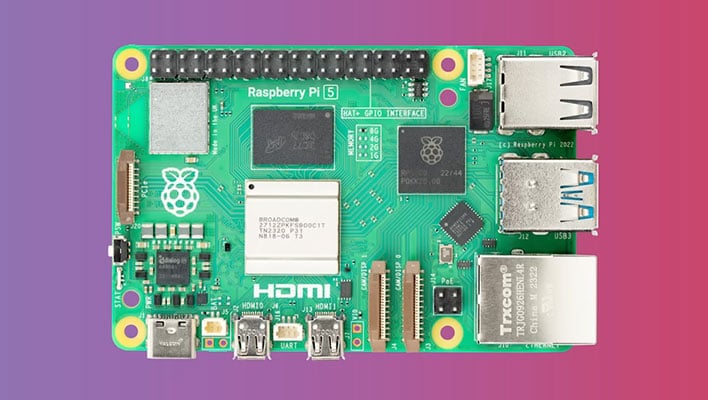Raspberry Pi 5 Arrives With A 2X Performance Uplift And Delicious Upgrades

Oh look, the Raspberry Pi Foundation has baked an all-new single board computer (SBC) to serve as its flagship dish for hobbyists, tinkerers, and modders, and it looks absolutely enticing. Scheduled to release next month, the Raspberry Pi 5 is the first in its rank to feature silicon designed in-house—namely, the southbridge chip. Yes, the firm also built a custom microcontroller chip for the Raspberry Pico, but that was technically a separate product line.
This is also the first Raspberry Pi model to sport a disaggregated chiplet architecture (like what Intel is doing with Meteor Lake, but obviously in a much different way). All of the previous Raspberry Pi models, including the Raspberry Pi 4, leveraged a monolithic application processor (AP) architecture where most of the I/O functions were integrated onto the AP. On the Raspberry Pi 5, most of the I/O functions to a separate and custom-designed I/O controller called RP1, save for fast digital functions, the SD card interface, and high-speed interfaces (SDRAM, HDMI, and PCI Express).
"It provides two USB 3.0 and two USB 2.0 interfaces; a Gigabit Ethernet controller; two four-lane MIPI transceivers for camera and display; analogue video output; 3.3V general-purpose I/O (GPIO); and the usual collection of GPIO-multiplexed low-speed interfaces (UART, SPI, I2C, I2S, and PWM). A four-lane PCI Express 2.0 interface provides a 16Gb/s link back to BCM2712," the developer says.
The custom chip has been in development since 2016 and has seen multiple evolutions before finally debuting in the Raspberry Pi 5. As for the engine that drives the latest SBC, it's still a Broadcom part based on Arm's IP. Specifically, it sports a Broadcom BCM2712 chip featuring a quad-core 64-bit Arm Cortex-A76 CPU with cryptography extensions, 512KB per core L2 caches, and a 2MB shared L3 cache.
Other notable specs include a VideoCore VII GPU, dual 4K60 HDMI outputs, 4K60 HEFC decoder, dual-band Wi-Fi 5 (802.11ac), Bluetooth 5.9 and Low Energy (BLE), high-speed microSD card interface (with SDR104 mode support), 2x USB 3.0 ports (simultaneous 5Gbps operation), 2x USB 2.0 ports, Gigabyte Ethernet (supports PoE+ with separate PoE+ HAT), 2x 4-lane MIPI camera/display transceivers, PCIe 2.0 x1 support, 5V/5A DC power via USB-C with Power Delivery support, 40-pin GPIO header, a real-time clock (RTC) powered from an external battery, and a power button.
The Raspberry Pi 5 purportedly delivers two the three times more CPU and GPU performance compared to the Raspberry Pi 4. It also more than doubles the memory bandwidth with a 32-bit LPDDR4X SDRAM subsystem running at 4,276MT/s, up from 2,000MT/s.
You can check out the lengthy Raspberry Pi 5 announcement for the full rundown but the short of it is, this is a worthy successor the Raspberry Pi 4. The only downside is that the added power and capabilities carry a heavier price—$60 for the 4GB model and $80 for the 8GB variant. As the Raspberry Pi Foundation notes, however, "virtually every aspect of the platform has been upgraded."

